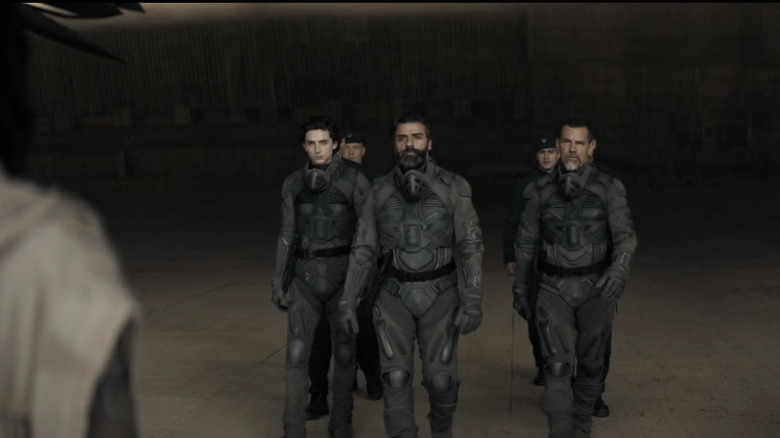Dune's Stillsuits Could Become Real – And Astronauts May Wear Them To Mars
Now that "Dune: Part Two" has smashed box office milestones and assured the spice will keep flowing with "Dune 3," it seems the universe first created by author Frank Herbert will be part of our cultural landscape for some time. While we await Denis Villeneuve's next film adaptation, the real world is actually catching up with the futuristic tech of "Dune" — specifically, with spacesuits that mimic the function of stillsuits from the novels and films.
In Herbert's 1965 novel "Dune," stillsuits are described as "a micro-sandwich — a high-efficiency filter and heat-exchange system." The suits, designed most effectively by the desert-dwelling Fremen people, allow wearers to traverse arid landscapes such as the planet Arrakis without running out of hydration. In the book, Herbert reveals that the suits not only recycle sweat, but that, "Urine and feces are processed in the thigh pads," so, yes, wearers are essentially drinking their recycled waste.
In Denis Villeneuve's "Dune," there's no mention of any waste-recycling thigh pads, but the idea is pretty much the same. Leto (Oscar Isaac) and Paul Atreides (Timothée Chalamet) meet with Imperial Planetologist Dr. Liet-Kynes (Sharon Duncan-Brewster) prior to venturing out into the deserts of Arrakis. At the meeting, Paul thanks the Liet-Kynes for the stillsuits, at which point the doctor properly introduces the technology. "A stillsuit is a high-efficiency filtration system," she explains, laying out how the stillsuits cool the wearers' bodies and recycle water lost to sweat. She continues, "Your body's movements provide the power inside the mask. You'll find a tube to allow you to drink the recycled water in good working order. Your suit won't lose more than a thimble full of water a day." Pretty neat stuff, but not as neat as the fact that real-life astronauts could soon be fitted with similar tech.
Real-life stillsuits could be used by NASA
The stillsuits in Denis Villeneuve's "Dune" were beautiful but not actually functional. Chani actor Zendaya previously told Total Film, "It takes a while to take it off, and the restrooms, you have to hike down quite a long way to get to the restrooms. So I was like, 'I just won't drink that much water." Unfortunately that led to the "Challengers" star becoming dehydrated very quickly. But while "Dune" and "Dune: Part Two" weren't quite able to fabricate functioning stillsuits, that doesn't mean it's an impossible task.
As reported by The Guardian, a prototype space suit that is actually "modeled on the stillsuits" promises to bring Frank Herbert's vision to life. The prototype, which could be used by the end of the decade, collects the wearers' urine and recycles it before returning it to the astronaut through a drinking tube. What's more, the whole process is said to take five minutes. As co-designer and researcher at Weill Cornell Medicine and Cornell University, Sofia Etlin, told the outlet:
"The design includes a vacuum-based external catheter leading to a combined forward-reverse osmosis unit, providing a continuous supply of potable water with multiple safety mechanisms to ensure astronaut wellbeing."
The idea is that these suits will allow astronauts to survive and work on other worlds for long periods. Currently, astronauts are provided with a liter (about 33.8 fluid ounces) of water in their suits. While that might be more than enough for the TSA to stop the astronauts at security, it certainly isn't enough for any kind of sustained on-planet missions. As Prof. Christopher Mason, of Weill Cornell Medicine, told The Guardian, "Even in the absence of a large desert planet, like in 'Dune,' this is something that could be better for astronauts."
Not exactly a stillsuit from Dune, but close
As The Guardian notes, NASA is set to launch a mission in 2026 — one that will hopefully see a crew land on the lunar south pole — and is aiming to send crews to Mars by the 2030s. The real-life stillsuits are designed with missions such as this in mind, and should be a heck of a lot better than the space-diapers astronauts are currently forced to wear (something which would've no doubt undermined the epic drama of Denis Villeneuve's "Dune" movies).
As explained in The Guardian's report, the real-life stillsuit design is seemingly much more focused on recycling urine than anything else. The outlet writes that the suit "comprises a collection cup of molded silicone to fit around the genitalia, with a different shape and size for women and men." The cup is held within a flexible fabric inner suit and connects to a "moisture-activated vacuum pump," which diverts moisture to a filtration system that has what is frankly an alarmingly low efficiency of "87%." The (somewhat) purified water is then returned to the wearer via a drinking tube. 100 volunteers will test out the prototype this fall, ahead of the technology's full deployment.
Is this exactly what Frank Herbert had in mind when designing his stillsuits? Well, not entirely, but it's pretty darn close. Coming, as it does, during a time when AI — once the villain of "Terminator" movies — is becoming a real and much more prevalent force within our own lives, the still suit design is yet another a reminder that we're closer than ever to living in the kinds of sci-fi worlds that just a few decades ago seemed like distant fantasies. Let's hope the next breakthrough involves getting that 87% filtration up a tad.


